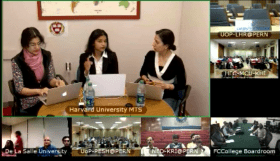 Mass casualty incidents, from terrorist attacks, floodings, earthquakes to bus accidents, are chaotic. With proper knowledge about the principles of triage, even those with no medical training can help.
Mass casualty incidents, from terrorist attacks, floodings, earthquakes to bus accidents, are chaotic. With proper knowledge about the principles of triage, even those with no medical training can help.
Mass casualty triage was the topic of SAI’s second webinar of the semester, on Nov. 19, on disaster management with Dr. Usha Periyanayagam (@uperiy), MD, MPH, International Emergency Medicine Fellow, Department of Emergency Medicine, Brigham & Women’s Hospital; Harvard Medical School.
Eight universities from three countries in South Asia participated in the interactive session, using videoconference software provided by the Higher Education Commission of Pakistan (HEC), with a participation of around 100 students in South Asia, with many more watching online.
Dr. Periyanayagam has worked with SAI and the Aman Foundation to improve disaster response in Karachi, and has extensive experience in emergency settings around the world.
During the webinar, Dr. Periyanayagam explained that “triage” is not treatment – it is a method of sorting injured people and deciding who gets treatment first. “The goal of triage is doing the greatest good for the greatest number – it’s not doing everything you can for every patient,” Dr. Periyanayagam explained. She cited the 2013 Boston marathon bombing as an example of triage working correctly – of the 250 who were injured, no one who was transported to hospital died.
In many places in the developing world, including South Asia, inefficient triage can lead to patients dying who could have otherwise been saved. For example, if someone is slightly injured but is still able to yell and talk, they are sometimes the first taken to the hospital because they are persistent. With proper triage, they should be the last treated – those who are most injured are the ones who can not vocalize that they need help.
For people with no medical training, Dr. Periyanayagam explained that there are four main questions that should be used to evaluate each injured person:
- Can they walk? Anyone who is able to walk on their own should be separated from the more seriously injured.
- Can they breathe? Ask people if they need help, and anyone who can yell or scream is able to breathe sufficiently.
- Do they have a pulse? Another useful tip is to test their capillary refill – if you press on their skin and the color does not quickly go back to normal, they are seriously injured.
- Can they follow commands? Whether or not they are following instructions is an indicator of their mental state.
After a 15-30 second evaluation for each injured person using the questions above, Dr. Periyanayagam explained the process of color coding the injured. It is important to keep groups separate if possible to prevent confusion. The injured should be split in to four color categories, which will indicate how quickly they should get to a hospital:
- Black: Dead or unsalvageable, and will be brought to the morgue.
- Red: In need of immediate treatment, and will go to a hospital first. Red patients have abnormal breathing, pulse, and mental status.
- Yellow: Will receive delayed treatment. They have normal breathing, normal cap refill, and normal mental status.
- Green: Anyone who is wounded but walking – they should go to a clinic or somewhere other than hospital.
Dr. Periyanayagam also shared some tips for treating patients in the field even if you do not have a medical background. Controlling hemorrhage should be the first task, since loss of blood frequently leads to death for trauma patients.
First, pressure should be applied to the site that is bleeding, even if it causes pain. Dr. Periyanayagam said that many people make the mistake of not pressing hard enough because it pains the patient. Next, the bleeding body part can be lifted above the heart, which can help stop the bleeding.
Dr. Periyanayagam explained that tourniquets should be used only if all other attempts to control bleeding has failed. A tourniquet is a device used to stop bleeding by tying something tight above the injured body part, but can be dangerous and can cause damage. A tourniquet can be made with what is available, for example a scarf or belt, and should not be used for more than 90 minutes, or the result can be permanent damage.
Spinal immobilization is also important to make sure that a person is not paralyzed. Dr. Periyanayagam explained that it is important that the injured cannot turn their back or neck, so use anything you have available to immobilize them – for example, two shoes taped around the head. A splint can also be made using available materials, to set a broken leg or arm.
The webinar was a valuable instructional tool in the principles of triage, that should be widely known to everyone, even those not in the medical community. “Doing something is still better than doing nothing,” Dr. Periyanayagam said, in situations with mass casualties.
Students and faculty at participating universities had the opportunity to ask Dr. Periyanayagam questions directly during the webinar, as well as on social media. (See the conversation on Twitter here). Participating universities included Christ University in Bangalore, India, De La Salle University, Manila, Phillippines, and several universities from all over Pakistan.
The next webinar is TBD. Please check our website for updates. We will be adding more resources to our website in the future.
